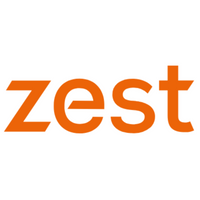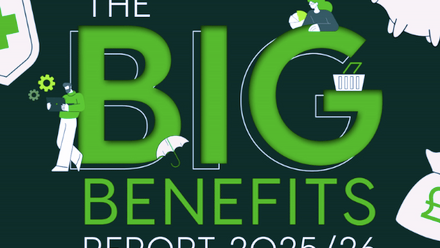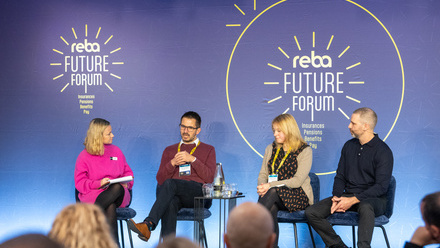Five questions about personalisation that you should ask benefits technology providers

As benefits technology catches up with the wider technology market, it’s right to expect that the personalisation we’re all so used to is also available from our benefit platforms too.
Personalisation will help employees to get the most out of their benefit scheme by creating personalised, user-friendly journeys. It should accelerate the decision making process and help to ensure that the right choices are made.
To ensure that you get the most from your benefits technology platform, we’ve formulated five key questions you should be asking of any benefits technology provider.
1. Does the platform offer personalised and relevant communications to employees?
You know your employees best and so it’s critical that your provider should be able to produce communications that reflect the language and tone that you want to use when communicating to your workforce.
In addition to the personalisation of the content, personalisation of appearance is also important. It is likely that your organisation has invested heavily in creating their brand, they may have gone even further and developed a ‘benefits brand’, and you’ll want this to flow into the presentation of your communications.
Furthermore, communications should be specific and relevant to the individual. They should use dynamic data that reference the employee and their benefit choices and the actions that they have taken.
Communications should also enable you to target specific groups or individuals rather than sending blanket emails that are irrelevant. For example, it is confusing to generate reminder emails to employees who have already completed the task at hand. Alternatively, you may want to run a campaign drawing attention to a specific benefit among employees that meet a certain demographic criteria or that have not taken up particular benefits or benefit types.
Communications should engage and excite your workforce in their benefits scheme, not turn them off. Good communication personalisation equips you with the ability to achieve just this. When talking to a technology provider you should ask:
- Can you easily amend the content and appearance of communications?
- Are communications personal and specific to the recipient?
- Can you target communications to specific groups or individuals?
- Can you trigger emails based on rules?
2. Can the platform determine an individual’s eligibility and only display what’s relevant and accurate?
Benefit schemes can be complex; varying benefit eligibility, step rule restrictions, differing rates and funding levels… However, this should not affect the employee experience, which should remain clear, accurate and relevant. Too much information, especially irrelevant information, makes it difficult for employees to make the right choices.
Individuals should only see the benefits and the cover options within those benefits that are available to them. The accompanying benefit content should accurately reflect their options. The costs displayed should be the true cost to that individual.
By providing simple, clear choices through your benefits technology you can boost employee engagement with your reward and benefit programme. Making selections clearer and easier to complete will reduce user frustration and confusion, and ultimately cut the amount of time you need to spend answering queries and managing dissatisfied employees. All helping to lower drop-off rates and encourage higher engagement levels. When talking to a technology provider ask:
- Can you determine employee’s eligibility for windows, benefits and cover options, and is that eligibility reflected in the interface?
- Can the benefit content dynamically reflect the options available to the individual?
- Are costs accurate, reflecting the employee age, gender, funding levels and so on?
3. Can the platform be branded to reflect our benefits brand or corporate brand?
Creating a platform which is cohesive with your organisation’s brand (or benefits brand) can often be key to your reward and benefits programme success. Building in imagery, written content, brand colours and logos creates an all-encompassing feel when it comes to your benefits scheme. It can really help build your reputation as a ‘caring company’, driving home the value of your organisation.
You may want to regularly update that appearance in coordination with campaigns that you are running, or to refresh the brand according to the season to keep the site feeling fresh and exciting.
It’s helpful to ask your provider:
- What customisation can be achieved on the platform?
- How can I reflect my organisations tone of voice?
- How easy is it to personalise the platform and what’s the cost involved with refreshing that branding?
4. Things change, so how easy is it to update the personalisation we have in place and what will this cost?
Nothing is ever set in stone and any successful reward and benefits programme will change with the needs and wants of its workforce. Sometimes that’s a few additional lines of information, shedding a little more light on the benefit that’s had a few enquiries. Other times it’s a complete branding refresh or a whole new suite of benefits. You want to able to enable these changes quickly and easily, and hopefully with very little impact on your budget. It’s always key to consider the following when talking to a technology provider:
- How easy is it to update information?
- Can we implement certain changes ourselves, such as updating benefit content or communications?
- What are the costs involved with changes to benefits, content, branding and communications?
5. Does the platform get to know the person?
The previous questions really should be considered as the basics that any provider must offer, but ideally your benefits technology should be going a step further. It should be able to understand the employee and adapt the user experience according to what has been learnt.
Surveys can be a great way of understanding relevant information about the employee. A question such as ‘how do you get to work?’ may determine the priority in which a season ticket loan, an ultra-low emission car scheme or cycle to work scheme are presented as options to an employee. Alternatively, understanding the employee’s lifestyle goals, such as keeping fit and healthy or ensuring that their family is provided for, may affect whether health and wellbeing benefits or risk benefits are given more weight within the platform.
Your benefit platform will already know basic information about the employee such as their age, gender, salary and whether they have a family. The appearance of the portal could respond to this, so rather than disengaging a 20-year-old single male with lots of imagery of families for example, lifestyle imagery more appealing to the individual can be displayed. More importantly, the platform can prioritise the display of benefits that we know to have greater appeal to individuals’ demographic, based on insights using big data.
Benefits technology can also be used to educate and encourage good behaviours. Nudge-like messages suggesting employees start saving earlier or contributing more to their pension, can be effective in driving better take up or higher contributions.
Round up
These five questions are a great starting block to help you understand everything you need to know about the personalisation of employee benefits technology. From visual to communications and eligibility, your technology should be able to provide a truly personal and tailored experience for every employee.
Don’t just look for a tick in the box, ask for the provider to demonstrate and explain exactly how you can achieve personalisation at each step of the way. As every organisation is different, from business objectives through to the people you hire, it is important to understand exactly how your scheme to works and what your objectives are. From this, your provider can credibly demonstrate what your platform will be truly capable of.
The author is Emma Norman, product manager at Zest.
This article was provided by Zest.
Zest is sponsoring REBA’s Innovation Day, taking place on 22 November at County Hall, London.
Supplied by REBA Associate Member, Zest
Zest is the next generation platform that’s reinventing the world of employee benefits.







